
Bilstein 5160 & 6112 – The Complete Guide for the 5th Gen Owner
A suspension is crucial to any vehicle – whether you have a performance sports car, off-road vehicle, all-terrain vehicle, or anywhere between. The reason you need a good suspension is that suspension heavily controls how your vehicle handles and keeps your tires on the ground.
For some people, they want a solid ride on the road and don’t care much about off-road handling. Others want something that resembles a trophy Baja truck that can fly through bumps at 50+ mph. Of course, there is everything in between as well.
The important thing to remember is that although a Baja truck can fly through rough terrain, it is nowhere near ideal for daily driving… and almost dangerous if you ever have to do a quick maneuver.
On the other hand, you are not going to have a nice ride if you take a vehicle with on-road suspension off-road, you might even break something.
Although the 5th Gen 4Runner comes with a solid suspension from the factory, it can be drastically upgraded.
What suspension upgrade?
- Fox shocks
- King
- Icon
- Bilstein
I will admit, I wasn’t as knowledgeable about suspension as I thought I was until I decided I was going to upgrade the suspension on my 2017 4Runner TRD Off-Road and researched it heavily – and I mean heavily.
Bilstein 6112 and 5160 Lift:
- Bilstein 5100/5100 (no UCA): Check Price
- Bilstein 5100/5100 (add UCAs): Check Price
- Bilstein 6112/5160: Check Price
- Recommended Upper Control Arms (SPC): Check Price
- Rear Spring (ICON 52700): Check Price
Fox, King, Icon, and Bilstein?

I’d heard of Fox, King, Icon and Bilstein, but what makes one better than the other? The answer is neither one is “better”, one is just better suited for your application and style.
Going straight for Fox
When I first started looking for some new suspension on my 4Runner I went straight to Fox. The reason being the popularity, following, and publicity that Fox has. Another reason was my 2018 Specialized Camber Comp 29 mountain bike has Fox suspension with adjustable compression and dampening… and man it is amazing. It can soak up bumps like I never knew possible. I also have a friend who has a semi-trophy truck loaded with the finest shocks Fox has to offer.
The problem is that my bike only has two wheels and 4Runners have four, and I don’t have or want a trophy truck… or thousands of dollars to spend on suspension. Although my mountain bike and my friend’s truck with Fox shocks handle off-road amazingly, I have a 4Runner that I use as my daily driver and spend at least 95% of the time on-road. I also don’t want to add any more body roll or nose dive to my 4Runner.
Suspension upgrade that was under $1,500
As I researched further into shocks it became evident that the engineering that goes into the valving and design of shocks is unbelievable. As an engineer myself, I began to understand the differences, benefits and negatives of each type of design.
Each company and each shock has its own unique valving and characteristics that can make it handle better in one situation, but potentially not as good in another area. Basically, I am trying to say it is nearly impossible to have a shock that is perfect both on and off-road.
Of course, as with everything, money can get you a much fancier shock with adjustability, bypass zones, and much more. However, I was looking for a suspension upgrade that was under $1,500 for new front and rear shocks so aspects such as adjustable compression, rebound, and bypass zones were somewhat out of the picture.
The need for on-road shocks vs. off-road shocks
I really wanted to get Fox shocks, but the more I researched I realized how much these shocks were actually meant to be utilized off-road… just like the shocks on my mountain bike. You can no doubt drive on road with this suspension, but there are other suspensions far better suited for on-road use than Fox shocks can provide, it really just depends on the type of performance you are looking for.
I want to be completely honest that although I have an extremely capable 4Runner, I drive it on road at least 95% of the time, maybe more.
I don’t want to sound like some hardcore off-roader. Even though I do take my 4Runner in some extreme terrain when I do go off road for fishing, mountain biking, traveling and just weekend drives, I am still on road 95% of the time and it didn’t seem practical to decrease the on-road handling of my 4Runner just to improve the 5% of time that I am off-road.
What I wanted was a suspension system that would benefit me on-road as well as give me more off-road capability. But is there such a shock?
Making my way to Bilstein Shocks
Here is where Bilstein shocks come into the picture. All TRD Pro 4Runners (prior to the new 2019s) came with Bilstein shock absorbers.
Although the new TRD Pro 4Runners come with Fox shocks, these shocks have bypass zones and other technology that drastically increase the price of the suspension making it far more expensive than other options and therefore out of my budget.
You might ask why Toyota went away from the Bilstein setup on the TRD Pros and switched to Fox.
Well, quite frankly I believe it is because Toyota wanted the TRD Pro 4Runner to be even more off-road worthy, and when it comes down to it, the Fox shocks they put on the 2019 TRD Pro are more off-road worthy…but not necessarily more on road worthy.
If you don’t want this type of off-road shock, then you get the next best 4Runner…the TRD Off-Road. This is simply my opinion, but I think it makes sense.
Bilstein 6112 and 5160 Suspension Setup

Essentially, the suspension that I decided to go with is what the TRD Pro 4Runner (2018 and older) came with. In the front, the 6112 shocks have ride height adjustability so you can lift the front of your 4Runner anywhere form 0 – 2.5”.
They also have a larger, 60mm digressive piston so you are increasing the amount of oil you have significantly, which correlates to a more rugged shock that prevents shock overheating and can handle longer periods of continuous suspension demand in comparison to the factory shocks.
The overall shock construction is more rugged than the factory front shocks and other options such as the Bilstein 5100s, as the 6112 come with a larger diameter shaft for increased durability. The 6112 also give more suspension travel (new upper control arm needed to gain the extra travel though).
In the rear, the 5160’s are the same diameter piston as factory, however, they come with a remote reservoir so once again you gain the benefit of increased oil capacity…but more importantly the remote reservoir gives you more suspension travel by allowing components that would otherwise be in the main monotube to be located in the reservoir, and therefore giving you extended travel.
The 5160s also come with a larger diameter shaft for increased durability and rigidity just like the 6112s.
Bilstein 6112 (Front Shock)

As to the design of these shocks, they have digressive valving.
I will need to publish a different article on the three types of valving, but for the purposes of this article digressive valving means the shock dampening curve digresses as the shaft speed increases.
This might not make sense, but it essentially means that these shocks react more when the shock shaft is traveling at a higher velocity. This typically corresponds to larger impacts and bumps, meaning these shocks won’t make smaller bumps silky smooth, but they do a great job at making larger bumps not so jarring.
In my opinion, this is why I think these shocks are so good for someone who uses their 4Runner as a daily driver and spends 95% of the time on-road.
Body Roll and Nosedive
Depending on where you live, roads should be relatively smooth. Of course, your suspension still does a lot of work, but not as much as off road. One thing a lot of people notice with a 4Runner is that it nosedives when braking… a lot. This is because it has a relatively soft suspension from the factory in order to smooth out bumps when going off-road.
When off-road at slower speeds, this is a good thing; however, on road, this gives the 4Runner a clumsy feel with not much composure and also is not the best at higher speeds off-road.
The 4Runner has quite a bit of body roll when changing lanes quickly, going around a tight corner, or if you ever have to make a maneuver to avoid an accident, debris in the road, etc.
All of this nose-diving and body roll decreases the reactiveness and handling of the 4Runner. In general, if you install progressive dampening shocks (like Fox shocks) you will tend to only further increase the nose-diving and body roll while driving on road. Considering most of us are on road the majority of the time this isn’t the best handling for driving on the highway and around cities.
The Bilstein 6112s and 5160s aim to improve on-road handling while still giving a capable off-road suspension… and I think they do just that.
What Front Lift?

A big question that many people might debate is how much lift to get. The 6112 shocks allow you to raise your 4Runner anywhere from 0 – 2.5 inches.
Here are the following heights you can go with:
- 2.5”
- 2.0”
- 1.6” – almost exactly level
- 1.2”
- 0.8”
- 0.0”
As you can see, you have quite a few options, but which one should you pick? It all depends on your application. If you are not going to lift the rear of your 4Runner in some form or fashion, I’d stay under a 1.6” front lift. The 1.6” front lift will be almost exactly level.
If you do decide to level your 4Runner, remember that it will look nice and level… but not if you are towing something or have a significant amount of gear in the back. The extra weight in the back will cause your nose to point up.
Higher lift = decrease on-road performance?
Another point to mention is the more you raise the front of your car the more you are raising the center of gravity. If you think about it, lifting the front of your car lifts the whole front of the car, including the engine which contributes a lot of weight. In consideration of this, lifting the front will improve off-road capability but decrease on-road handling.
CV axle angles
Lastly, you are also changing the angle of your front CV axles. This isn’t necessarily bad, but increasing the angle of the CV axle will create more wear and tear when 4WD is engaged as well as not transfer power as good as CV axles with flatter angles…however, these are small changes we are discussing so don’t be too alarmed, it is just something to consider that you might not think of.
To me, the 1.6” front lift looks good, however, I do carry quite a bit of gear in the back at times and didn’t want to “pop a wheely” down the road during these times. I also wanted to maintain solid CV axle angles as small of a reason as that may be.
What ride height is right for you?
I narrowed it down to the 1.2” front lift and 0.8” front lift. Ultimately, I decided to go with the 1.2” lift. Why? It was a good middle ground. The 0.8” lift wasn’t quite enough and the 1.6” lift was too high. I have just a slight forward rake and when I put some gear in the back I am pretty much level. Depending on the amount of gas I have in my tank, I have about a 0.5” – 0.75” difference in height from the front and back. With all my fishing and camping gear loaded up, it’s right around 0.25” difference.
Whatever front lift you decide to go with, if any, make sure to get an alignment afterward. The lift alters the geometry of the front suspension and alignment is needed to get it back to where it needs to be.
Extended Travel?

One of the benefits of installing the Bilstein 6112s and 5160s is increased suspension travel.
Why is this important? Have you ever been off road and one of your tires is in the air or almost in the air? Well, if you had more suspension travel your tires might have stayed on the ground, therefore giving you better traction and improving your safety while off road.
With the Bilstein 6112s and 5160s, you get extra suspension travel but not exactly “extended travel” like a Total Chaos Long Travel suspension. With this suspension, you will see about an inch of extra travel. However, you don’t get this travel right out of the box.
In the rear, the 4Runner has a solid axle. When you install the 5160s in the rear you gain the benefit of about 1.0” of extra travel just by installing the new shocks. The front isn’t quite so simple.
The front suspension has double wishbone independent suspension, and this means you don’t gain the additional travel unless you install aftermarket upper control arms. Even though you don’t gain the extra travel right out of the box, you are one step closer to having more travel in the front suspension by installing the 6112s.
Installation
Installing the 6112s and 5160s can be completed in your garage, but installing the front 6112s will require more time, tools and effort.
For a full reference on the 6112s and 5100s, check out this write up.
I will cover the installation of the 5160s briefly and then conclude with a summary of my overall impression on the suspension.
Step 1
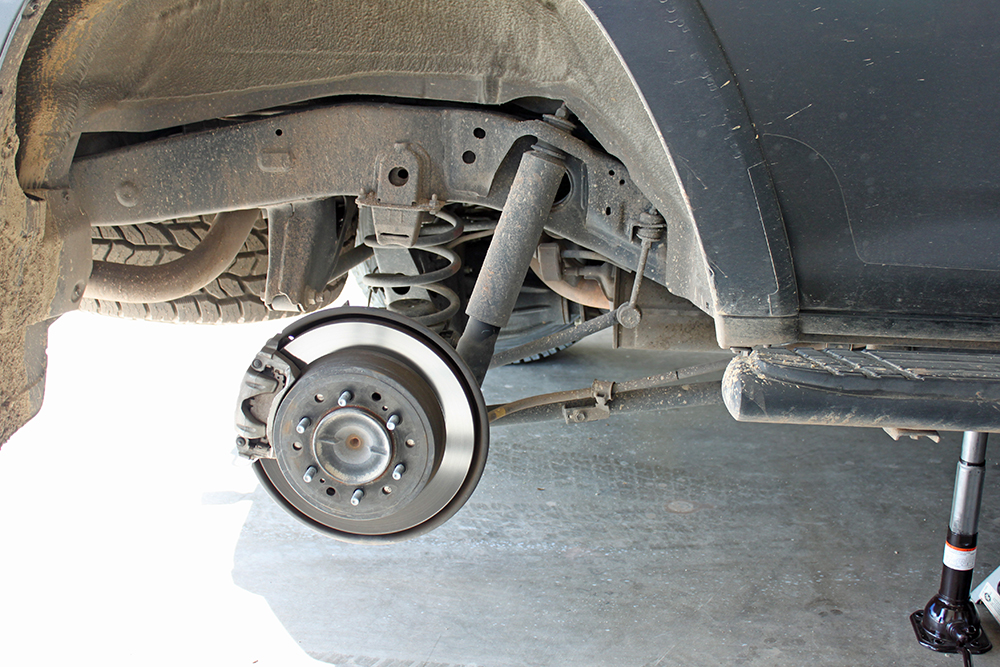
Since you will need to jack your vehicle up off the ground, it is important to be safe. Place blocks under the front tires to ensure your 4Runner will not roll forward or backward.
After doing so, loosen the lug nuts on one of the rear wheels. After loosening all the lugnuts (but not removing them) go ahead and position a jack under your 4Runner’s rear axle and lift it up so you have just enough clearance under the rear tire to remove it.
Note: it is important to lift your 4Runner in the rear by the axle so that it is under load. I place a jack/jack stand under the frame for safety reasons as well. Remove the tire and set it aside.
Step 2
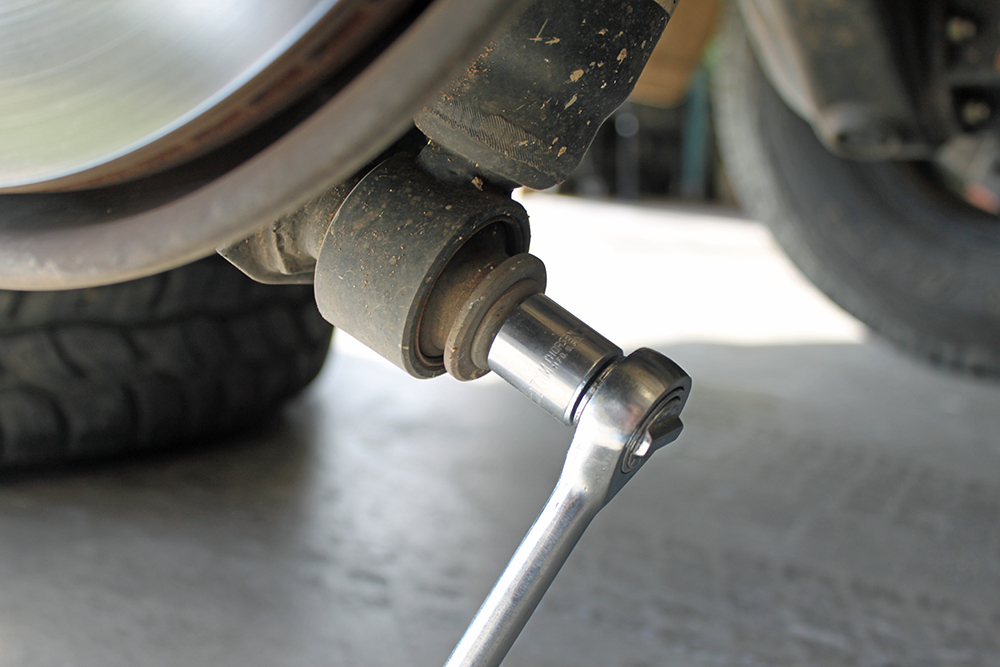
Remove the factory shock. This is straightforward and very simple to do. There is a nut at the top and a bolt at the bottom. I suggest removing the top nut first and then remove the bottom bolt.
Step 3
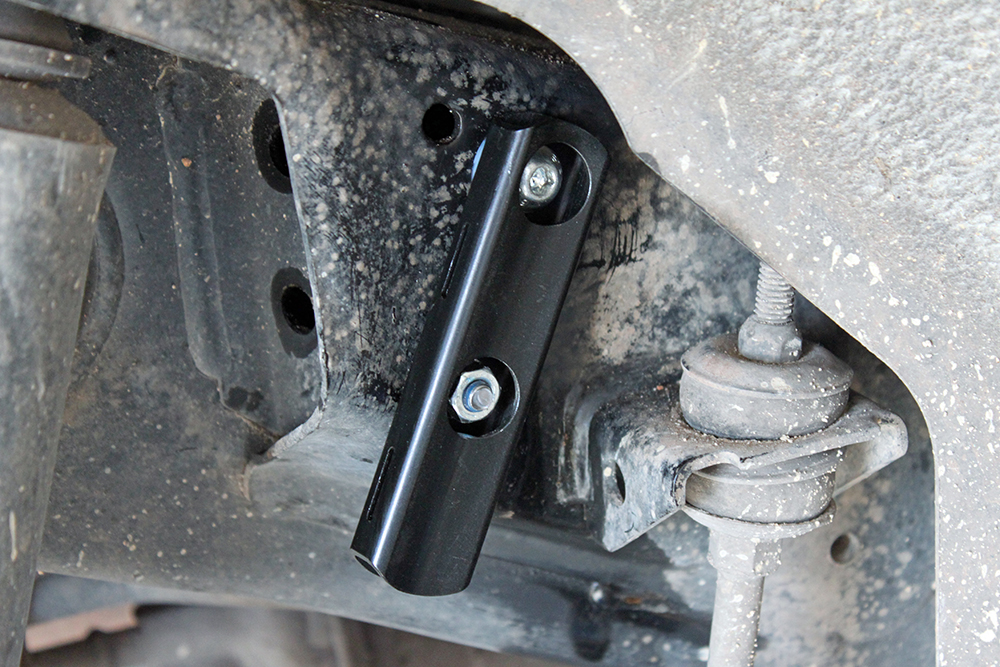
Install the brackets and worm clamps that hold the reservoir in place. I think Bilstein does a good job with their instructions so I will leave the actual instructions up to their instruction manual.
Step 4
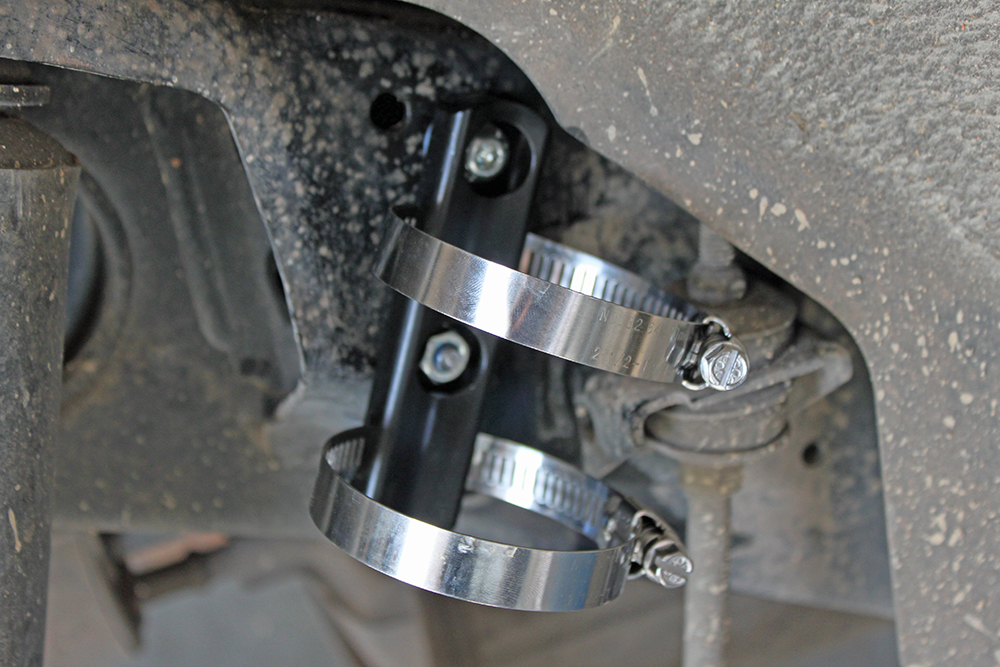
Position the top of your shock into the upper shock mount. Make sure that the shock stem has the lower washer and lower busing in place before pushing the shock stem through the upper shock mount. After placing the shock in the upper shock mount place the upper bushing and upper washer on the shock stem. Then secure the upper assembly with the M12 locknut.
Step 5
Using an assistant, slowly compress the shock and position into place on the lower shock mount. It does take quite a bit of force to compress the shock so two people are best. After positioning the lower portion of the shock in the lower shock mount, install the factory bolt and tighten.
Step 6

The last step is to simply install the reservoir into the worm clamps. Make sure to route the hose to the reservoir behind the main shock tube. After putting the reservoir into position, slowly tighten each worm clamp until the reservoir is secure.
Step 7

Enjoy your new suspension and a much more composed 4Runner – both on and off road.
On Road Handling
On road, the 6112 and 5160 shocks are unbelievable. They drastically transform the 4Runner into a much sportier and reactive vehicle. Due to the digressive valving, the Bilstein suspension makes the 4Runner feel much more composed.
There is much less nose diving when braking, body roll is significantly reduced and overall my 4Runner feels much more reactive and controllable.
I have also noticed I don’t get moved around by high winds on the highway as much either. Going around tight corners and quick unexpected braking have been drastically improved, and as I said, my vehicle is simply much more composed.
There is one road in particular where I live that has some turns that have pot holes right in the radius of the turns. With stock suspension, I would skip just slightly when I hit these holes going 50 mph around this corner.
With these new Bilstein shocks installed I can go around the corner and only feel a slight bump from the holes in the road. Without any hesitation, if you want to increase the on-road handling of your 4Runner, this is a great suspension system to install.
Gravel Roads

Here is where things get a little tricky to describe.
On relatively flat gravel roads the 6112 and 5160 suspension combination does great. You can really fly down the road and feel safe and composed while doing so.
If you are on a gravel road (or on road) with some potholes, the suspension might feel a little stiff or harsh. This is because of the digressive valving. It is hard to explain, but smaller bumps don’t make the suspension react very much.
This is why you have decreased nose dive and body roll, but also smaller bumps are a little harsher. However, if you are hitting some bigger bumps, these shocks react a lot and smooth out the ride much better than the factory suspension.
Off-Road Performance

Off road (slow, crawling) these shocks are pretty good. Although I would need to install new upper control arms to gain the additional travel that the 6112s can provide, I do gain additional travel in the rear from the 5160s and this helps out a lot.
Some obstacles that I used to cause a rear tire to be in the air no longer occur, as the extra travel (about 1-inch of extra travel) allow my rear tires to stay more planted. This gives me more traction, ride quality off road, and an overall safer vehicle.
Vehicle Loaded with Weight
One thing I have noticed with the installation of the Bilstein 6112s and 5160s is that they handle incredibly when the vehicle is loaded with a little bit of weight.
In fact, if you plan on overlanding, or just haul your family around a lot, these would make for a great setup. The extra oil capacity, increased suspension travel, and excellent ride quality when loaded up a bit make for an awesome overland suspension setup.
Overall Thoughts
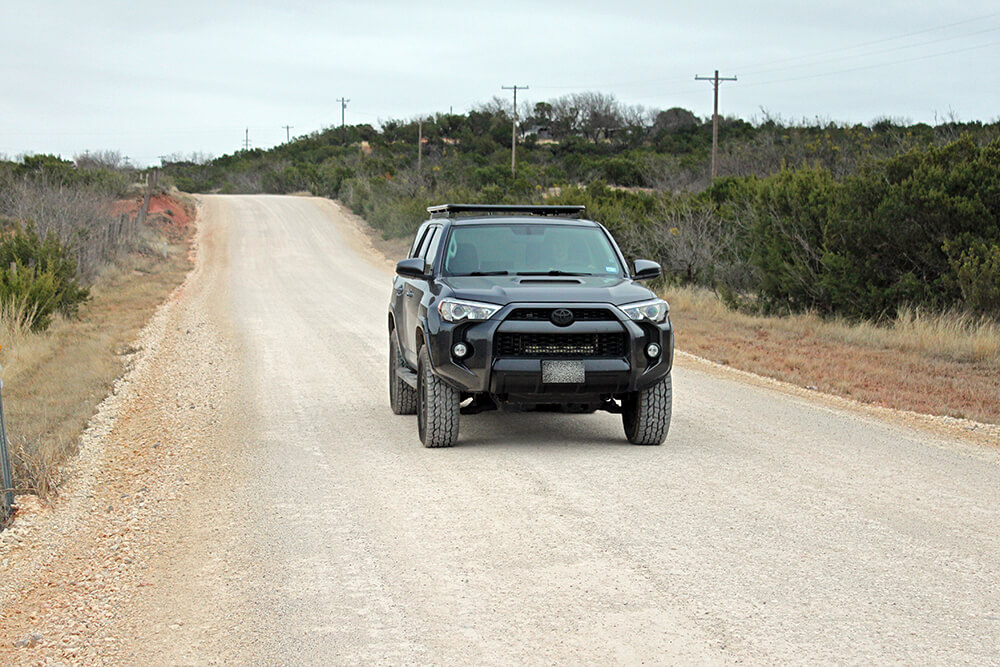
A suspension can be really tricky to understand, especially since some people might understand terms like digressive, progressive and linear valving while others may not.
What I can say is that after installing the Bilstein 6112s in the front and 5160s in the rear I gained a lot of on-road performance, increased my suspension travel for off-road, and overall improved my cars handling capabilities.
These shocks really shine on the road and are great off-road as well. The extra travel has already benefitted me off-road by helping my tires stay in contact with the ground.
Lastly, although smaller bumps may be transferred a little harsher into the cabin of my 4Runner, larger bumps have been significantly smoothed out by the digressive valving and has therefore given me a much more composed, and smoother ride.
Great suspension upgrade for around $1000
If you are looking for a suspension that is right around $1,000 that will significantly increase the 4Runner’s on-road handling, this may be a good option.
This setup also allows you to lift/level the front of your 4Runner, increase your suspension travel for the times you are flexing your suspension off-road.
If you are looking for these benefits and a more composed ride quality then I would consider installing the Bilstein 6112 and 5160 shocks.

Did you change/up grade the rear springs?
tya
Thanks for the info I just purchased
King springs on the 6112? Looking at the king it’s flat on both ends will this work on the 6112? 14x3x550
I am curious to the rear spring choice as well. I noticed a bit of a rear “squat” after installed these but did not think much of it. However after getting a rear tire hitch installed, this squat became dramatic. Would including the 2″ lift springs help with this or is this caused by settings? Currently running 285/70-17s
What is the difference between the new part number 6112 47-310025, and the old part number. the old ones are about $300 less
2018 4Runner TRD PRO
I loved this discussion, and the breakdown even more. I myself am in the market for new suspension.
I actually went the opposite way initially. I came to the conclusion I wanted the same set up such as yourself, with the 6112s in the front coilovers (lift TBD) and 5160s with reservoirs. My car came stock with rear reservoirs so it only makes sense to ensure the new setup has the same (for me at least).
Where I am struggling is, I found numerous write ups online that discussed their rear 5160s leaking. Not over a period of time but within 5K miles and minimal off road use. I like yourself, spend majority of my time on the road, and when I can I make it offroad but it’s probably around 5%.
That being said, I then found my way over to Fox and am certain I want to settle on the Fox 2.0 front/rear combo. I haven’t made the purchase yet but am hesitant mainly for the same reasons you stated… I don’t know if the car needs such a crazy set up if I am not going to be using them for what they are made for. But then again, my TRD Pro probably isn’t being used for what it was made for to begin with.
All in all… I haven’t made a decision yet, and am curious to hear any thoughts or suggestions regarding a potential leak with 5160s. Has anyone else heard anything similar to this?
Look at Elka
Great write up!
There’s 2 versions of the 6112 w/different circlip height adjustments.
Part #47-310025 / Model #E4-WM5-Y691A00: https://productdesk.cart.bilsteinus.com//media/products/bilstein/E4-WM5-Y691A00_2.pdf
and
Part #47-281202 / Model #E4-WM5-Y586A00:
https://productdesk.cart.bilsteinus.com//media/products/bilstein/E4-WM5-Y586A00_4.pdf
What do you suggest for 2011 TE (all original 495,000 kms) with non functional KDSS? All on-road rather than off-road use.
Thanks
Great write-up, thanks.
I presently have 0.85 in lift(Bilstein 5100) in the front and plan on installing 1.5 in Bilstein coils(and 5100s) in the back followed by increasing my front Bilsteins to 1.7 inches. Anyone know how much lift you can put up front and still be able to get a proper alignment done(assuming stock UCAs)?
Thank you
Could you discuss the use of aftermarket rear springs with this setup? You provided a link to ICON rear springs but didn’t really discuss why to consider them. Thanks!
I’m also interested in hearing what rear springs this setup will work with. I have 2-3″ lift rear springs (AFE Sway-A-way) and their shocks don’t work.
did u use the stock rear springs
I’ve followed your site for a while now, lot of good information. You are clearly knowledgeable and very detailed in passing on information. I have a 2018 TRD Off-Road Premium and have been debating whether or not I want to lift it a couple inches and put after market suspension on it.
One thing in the article that I don’t understand is the reference that seems to contradict with another article on 4Runner mods/lifts where you said “the Bilstein line of shocks is also progressive…”
https://trail4runner.com/2017/06/14/5th-gen-4runner-mods-lift-kits/
Above, the article states:
On road, the 6112 and 5160 shocks are unbelievable. They drastically transform the 4Runner into a much sportier and reactive vehicle. Due to the digressive valving”
Help me understand if I’m misinterpreting the statements from two different posts on your site. Thanks for any clarification.
Hi, my mechanic is telling me that the 6112 will not fit my 2018 4runner. He says the 6112 is for an F150 and he is recommending 5160 and 5100. However I keep reading about people doing this combo. Will it work on a 2018 4runner.
Stephanie, Clint helped me with several questions regarding this set up for my 2020 TRD OP. The 6112/5160 will absolutely work. I went with the Bilstein 1″ rear spring in the rear as well. I have KDSS and the clips for the 6112s are set at 5 on both sides. It provided about 2″ of lift in front and maintain a slight rake with the new rear springs. I’ve been very happy with the ride and appearance. Good luck!
Hey Dan – I’m getting 6112/5160s installed next week with the 1″ rear spring. I have KDSS as well. I’ve actually been back and forth between the 3rd clip (1.7″ expected) and the 4th clip (2″ expected). Sounds like you got less than what Bilstein expects, though. Any chance you could post some pictures of your ride (or send them my way)? Thanks!
How high did you end up going? I’m getting mine tomorrow and I’m going 2.5″ and 1.5″.
great post! Was interested in getting this set up for my wife’s 2021 TRD off road 4Runner. This Item is currently out of stock at most places. So I temporarily put in 3inch spacer lift so I could get larger 285/70 R17 KO2’s that was already purchased. The question now if these shocks will provide enough lift to clear the new tires.
Check out this article, it is possible!
https://trail4runner.com/2018/01/25/bigger-tires-4runner-cutting-trimming/
I am confused. I know I need a lift and my skid plates can provide evidence. I also know I need sliders. So, aside from shocks, what else is involved in the lift? How do I keep my front end sensor working? I am a weekend off roader, some rock climbing, dune racing, and back country exploring in Nevada. I have a 2020 4runner Off road premium with Kdss.
With the 6112 and added weight of low pro steel bumper, winch, sliders, aluminum skid, full roof rack, dual battery what spring would you recommend to keep the 2.5” lift? I see bilstein offers a heavier spring now but will that 650 spring be enough? Or should I go with a 700 lb spring and less pre load
Adam-
Did you ever get an answer (Here or elsewhere) on your question? I’ve installed this system and I’m in the same boat. I’ve added weight since the install and not sure if 650’s will cut it.
Trail Safe
-JB
Hey JB I did run the kings temporarily and the ride did not suffer but I ultimately switched out to the dobinsons ims kit and the ride is even better now.
Hey THANKS Adam.